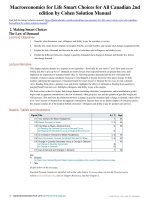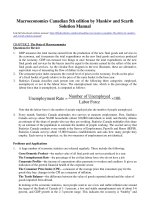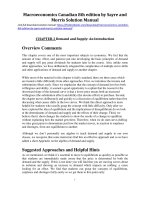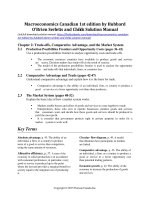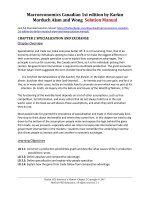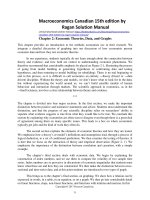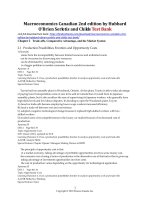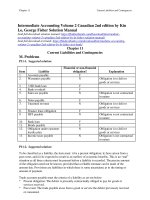Macroeconomics canadian 2nd edition by hubbard OBrien serletis and childs test bank
Bạn đang xem bản rút gọn của tài liệu. Xem và tải ngay bản đầy đủ của tài liệu tại đây (2.19 MB, 113 trang )
Macroeconomics Canadian 2nd edition by Hubbard
O'Brien Serletis and Childs Test Bank
Link full download test bank: />Chapter 2 Trade-offs, Comparative Advantage, and the Market System
2.1 Production Possibilities Frontiers and Opportunity Costs
1) Scarcity
stems from the incompatibility between limited resources and unlimited wants.
can be overcome by discovering new resources.
can be eliminated by rationing products.
is a bigger problem in market economies than in socialist economies.
Answer: A
Diff: 2 Page Ref: 36
Topic: Scarcity
Learning Outcome: 2.1 Use a production possibilities frontier to analyze opportunity costs and trade-offs
AACSB: Reflective Thinking
Special Feature: None
Toyota built an assembly plant in Woodstock, Ontario. At this plant, Toyota is able to take advantage
of paying lower transportation costs on cars to be sold in Canada than it would from its Japanese
assembly plants, but it also sacrifices the ease of supervising its Japanese workers, who generally have
high skills levels and few labour disputes. In deciding to open the Woodstock plant, Toyota
A) faced no trade-offs because employing lower-wage workers increased efficiency.
B) faced a trade-off between cost and convenience.
C) adopted a negative technological change because it replaced high-skilled workers with lowskilled workers.
D) eroded some of its competitiveness in the luxury car market because of its decreased cost of
production.
Answer: B
Diff: 2 Page Ref: 35
Topic: Opportunity Cost
2CE: Classic (1CE)- updated for 2CE
Learning Outcome: 2.1 Use a production possibilities frontier to analyze opportunity costs and trade-offs
AACSB: Analytic Skills
Special Feature: Chapter Opener: Managers Making Choices at BMW
The principle of opportunity cost is that
in a market economy, taking advantage of profitable opportunities involves some money cost.
the economic cost of using a factor of production is the alternative use of that factor that is given up.
taking advantage of investment opportunities involves costs.
the cost of production varies depending on the opportunity for technological application.
Answer: B
Diff: 3 Page Ref: 36
Topic: Opportunity Cost
Learning Outcome: 2.1 Use a production possibilities frontier to analyze opportunity costs and trade-offs
AACSB: Reflective Thinking
Special Feature: None
1
Copyright © 2018 Pearson Canada, Inc.
The production possibilities frontier shows the ________ combinations of two products that may
be produced in a particular time period with available resources.
A) minimum attainable
B) maximum attainable
C) only
D) equitable
Answer: B
Diff: 2 Page Ref: 36
Topic: Production Possibilities Frontiers
Learning Outcome: 2.1 Use a production possibilities frontier to analyze opportunity costs and trade-offs
AACSB: Reflective Thinking
Special Feature: None
The production possibilities frontier model shows that
if consumers decide to buy more of a product its price will increase.
a market economy is more efficient in producing goods and services than is a centrally planned
economy.
economic growth can only be achieved by free market economies.
if all resources are fully and efficiently utilized, more of one good can be produced only
by producing less of another good.
Answer: D
Diff: 2 Page Ref: 36
Topic: Production Possibilities Frontiers
Learning Outcome: 2.1 Use a production possibilities frontier to analyze opportunity costs and trade-offs
AACSB: Analytic Skills
Special Feature: None
The production possibilities frontier model assumes which of the following? A)
Labour, capital, land and natural resources are unlimited in quantity.
B) The economy produces only two products.
C) Any level of the two products that the economy produces is currently possible.
D) The level of technology is variable.
Answer: B
Diff: 2 Page Ref: 36
Topic: Production Possibilities Frontiers
Learning Outcome: 2.1 Use a production possibilities frontier to analyze opportunity costs and trade-offs
AACSB: Reflective Thinking
Special Feature: None
The attainable production points on a production possibility curve are
the horizontal and vertical intercepts.
the points along the production possibilities frontier.
the points outside the area enclosed by the production possibilities frontier.
the points along and inside the production possibility frontier.
Answer: D
Diff: 2 Page Ref: 36
Topic: Production Possibilities Frontiers
Learning Outcome: 2.1 Use a production possibilities frontier to analyze opportunity costs and trade-offs
AACSB: Reflective Thinking
Special Feature: None
2
Copyright © 2018 Pearson Canada, Inc.
The points outside the production possibilities frontier
are A) efficient.
B) attainable. C)
inefficient. D)
unattainable.
Answer: D
Diff: 2 Page Ref: 37
Topic: Production Possibilities Frontiers
Learning Outcome: 2.1 Use a production possibilities frontier to analyze opportunity costs and trade-offs
AACSB: Reflective Thinking
Special Feature: None
Figure 2.1
Refer to Figure 2.1. Point A
is A) technically efficient.
B) unattainable with current resources.
C) inefficient in that not all resources are being used.
D) the equilibrium output combination.
Answer: C
Diff: 1 Page Ref: 37
Topic: Production Possibilities Frontiers
Learning Outcome: 2.1 Use a production possibilities frontier to analyze opportunity costs and trade-offs
AACSB: Reflective Thinking
Special Feature: None
Refer to Figure 2.1. Point B is
technically efficient.
unattainable with current resources.
inefficient in that not all resources are being used.
the equilibrium output combination.
Answer: A
Diff: 1 Page Ref: 37
Topic: Production Possibilities Frontiers
Learning Outcome: 2.1 Use a production possibilities frontier to analyze opportunity costs and trade-offs
AACSB: Reflective Thinking
Special Feature: None
3
Copyright © 2018 Pearson Canada, Inc.
Refer to Figure 2.1. Point C is
A) technically efficient.
B) unattainable with current resources.
C) inefficient in that not all resources are being used.
D) is the equilibrium output combination.
Answer: B
Diff: 1 Page Ref: 37
Topic: Production Possibilities Frontiers
Learning Outcome: 2.1 Use a production possibilities frontier to analyze opportunity costs and trade-offs
AACSB: Reflective Thinking
Special Feature: None
Refer to Figure 2.1. At point A the opportunity cost of producing more SUVs is
0 roadsters.
0 SUVs.
2.5 roadsters per SUV.
impossible to determine.
Answer: A
Diff: 2 Page Ref: 37
Topic: Opportunity Cost
2CE: New to 2CE
Learning Outcome: 2.1 Use a production possibilities frontier to analyze opportunity costs and trade-offs
AACSB: Analytic Skills
In a production possibilities frontier model, a point ________ the frontier is productively
inefficient. A) along
B) inside
C) outside
D) at either intercept of
Answer: B
Diff: 1 Page Ref: 37
Topic: Production Possibilities Frontiers
Learning Outcome: 2.1 Use a production possibilities frontier to analyze opportunity costs and trade-offs
AACSB: Reflective Thinking
Special Feature: None
Bella can produce either a combination of 60 silk roses and 80 silk leaves or a combination of 70
silk roses and 55 silk leaves. If she now produces 60 silk roses and 80 silk leaves, what is the
opportunity cost of producing an additional 10 silk roses?
A) 2.5 silk leaves
B) 10 silk leaves
C) 25 silk leaves
D) 55 silk leaves
Answer: C
Diff: 2 Page Ref: 37
Topic: Opportunity Cost
Learning Outcome: 2.1 Use a production possibilities frontier to analyze opportunity costs and trade-offs
AACSB: Analytic Skills
Special Feature: None
4
Copyright © 2018 Pearson Canada, Inc.
If the production possibilities frontier is ________, then opportunity costs are constant as more of
one good is produced.
A) bowed out
B) bowed in
C) nonlinear
D) linear
Answer: D
Diff: 2 Page Ref: 37
Topic: Opportunity Cost
Learning Outcome: 2.1 Use a production possibilities frontier to analyze opportunity costs and trade-offs
AACSB: Reflective Thinking
Special Feature: None
Figure 2.2
Figure 2.2 above shows the production possibilities frontier for Atikamekw Cree (ca. 1600) with
a historical tradition of fishing and farming. Assume they produce two goods: fish and grains.
16) Refer to Figure 2.2. What is the opportunity cost of one kilogram of grain?
kilograms of fish
1.2 kilograms of fish
kilograms of fish
12 kilograms of fish
Answer: A
Diff: 2 Page Ref: 38
Topic: Opportunity Cost
Learning Outcome: 2.1 Use a production possibilities frontier to analyze opportunity costs and trade-offs
AACSB: Analytic Skills
Special Feature: Solved Problem: Drawing a Production Possibilities Frontier for Pat's Pizza Pit
5
Copyright © 2018 Pearson Canada, Inc.
17) Refer to Figure 2.2. What is the opportunity cost of one kilogram of Fish?
kilogram of grain
kilograms of grain
1.6 kilograms of grain
16 kilograms of grain
Answer: B
Diff: 2 Page Ref: 38
Topic: Opportunity Cost
2CE: Classic (1CE)- updated for 2CE
Learning Outcome: 2.1 Use a production possibilities frontier to analyze opportunity costs and trade-offs
AACSB: Analytic Skills
Special Feature: Solved Problem: Drawing a Production Possibilities Frontier for Pat's Pizza Pit
Refer to Figure 2.2. Suppose Atikamekw Cree are currently producing 60 kilograms of grain per
period. How much fish is it also producing, assuming that resources are fully utilized?
A) 45 kilograms of fish
B) 75 kilograms of fish
C) 80 kilograms of fish
D) 100 kilograms of fish
Answer: B
Diff: 2 Page Ref: 38
Topic: Opportunity Cost
Learning Outcome: 2.1 Use a production possibilities frontier to analyze opportunity costs and trade-offs
AACSB: Analytic Skills
Special Feature: Solved Problem: Drawing a Production Possibilities Frontier for Pat's Pizza Pit
Refer to Figure 2.2. The linear production possibilities frontier in the figure indicates that
Atikamekw Cree have a comparative advantage in the production of vegetables.
Atikamekw Cree have a comparative disadvantage in the production of meat.
the trade-off between producing fish and grain is constant.
it is progressively more expensive to produce fish.
Answer: C
Diff: 2 Page Ref: 38
Topic: Opportunity Cost
Learning Outcome: 2.1 Use a production possibilities frontier to analyze opportunity costs and trade-offs
AACSB: Analytic Skills
Special Feature: Solved Problem: Drawing a Production Possibilities Frontier for Pat's Pizza Pit
6
Copyright © 2018 Pearson Canada, Inc.
A production possibilities frontier with a bowed outward shape
indicates A) the possibility of inefficient production.
B) constant opportunity costs as more and more of one good is produced.
C) increasing opportunity costs as more and more of one good is produced.
D) decreasing opportunity costs as more and more of one good is
produced. Answer: C
Diff: 2 Page Ref: 41
Topic: Opportunity Cost
Learning Outcome: 2.1 Use a production possibilities frontier to analyze opportunity costs and trade-offs
AACSB: Reflective Thinking
Special Feature: None
Increasing opportunity cost is represented by a ________ production possibilities
frontier. A) linear
B) convex
C) concave
D) vertical
Answer: C
Diff: 2 Page Ref: 41
Topic: Opportunity Cost
Learning Outcome: 2.1 Use a production possibilities frontier to analyze opportunity costs and trade-offs
AACSB: Reflective Thinking
Special Feature: None
The slope of a production possibilities frontier
has no economic relevance or meaning.
is always constant.
is always varying.
measures the opportunity cost of producing one more unit of a good.
Answer: D
Diff: 1 Page Ref: 41
Topic: Opportunity Cost
Learning Outcome: 2.1 Use a production possibilities frontier to analyze opportunity costs and trade-offs
AACSB: Reflective Thinking
Special Feature: None
________ opportunity cost implies that as more resources are applied to producing one good,
that production increases by smaller and smaller amounts.
A) Increasing
B) Decreasing
C) Constant
D) Negative
Answer: A
Diff: 2 Page Ref: 41
Topic: Opportunity Cost
Learning Outcome: 2.1 Use a production possibilities frontier to analyze opportunity costs and trade-offs
AACSB: Reflective Thinking
Special Feature: None
7
Copyright © 2018 Pearson Canada, Inc.
If opportunity costs are constant, the production possibilities frontier would be graphed
as A) a ray from the origin.
B) a positively sloped straight line.
C) a negatively sloped curve bowed in toward the origin.
D) a negatively sloped straight line.
Answer: D
Diff: 1 Page Ref: 41
Topic: Opportunity Cost
Learning Outcome: 2.1 Use a production possibilities frontier to analyze opportunity costs and trade-offs
AACSB: Reflective Thinking
Special Feature: None
Figure 2.3
Refer to Figure 2.3. Sergio Vignetto raises cattle and llamas on his land. His land is equally
suitable for raising either animal. Which of the graphs in Figure 2.3 represent his production
possibilities frontier?
A) Graph A
B) Graph B
C) Graph C
D) either Graph A or Graph C
E) either Graph B or Graph C
Answer: A
Diff: 2 Page Ref: 41
Topic: Opportunity Cost
Learning Outcome: 2.1 Use a production possibilities frontier to analyze opportunity costs and trade-offs
AACSB: Reflective Thinking
Special Feature: None
8
Copyright © 2018 Pearson Canada, Inc.
Refer to Figure 2.3. Sergio Vignetto raises cattle and llamas on his land. Half the land is more
suitable for raising cattle and half the land is better suited for raising llamas. Which of the graphs in
Figure 2.3 represent his production possibilities frontier?
A) Graph A
B) Graph B
C) Graph C
D) either Graph A or Graph C
E) either Graph B or Graph C
Answer: C
Diff: 2 Page Ref: 41
Topic: Opportunity Cost
Learning Outcome: 2.1 Use a production possibilities frontier to analyze opportunity costs and trade-offs
AACSB: Reflective Thinking
Special Feature: None
Table 2.1
Production choices for Tomaso's Trattoria
Quantity of
Quantity of
Pizzas
Calzones
Choice
Produced
Produced
A
48
0
B
36
15
C
24
30
D
12
45
E
0
60
Refer to Table 2.1. Assume Tomaso's Trattoria only produces pizzas and calzones. A combination of
24 pizzas and 30 calzones would appear
A) along Tomaso's production possibilities frontier.
B) inside Tomaso's production possibilities frontier.
C) outside Tomaso's production possibilities frontier.
D) at the horizontal intercept of Tomaso's production possibilities frontier.
Answer: A
Diff: 2 Page Ref: 37
Topic: Production Possibilities Frontiers
Learning Outcome: 2.1 Use a production possibilities frontier to analyze opportunity costs and trade-offs
AACSB: Analytic Skills
Special Feature: None
9
Copyright © 2018 Pearson Canada, Inc.
Refer to Table 2.1. Assume Tomaso's Trattoria only produces pizzas and calzones. A combination of
36 pizzas and 30 calzones would appear
A) along Tomaso's production possibilities frontier.
B) inside Tomaso's production possibilities frontier.
C) outside Tomaso's production possibilities frontier.
D) at the horizontal intercept of Tomaso's production possibilities frontier.
Answer: C
Diff: 2 Page Ref: 37
Topic: Production Possibilities Frontiers
Learning Outcome: 2.1 Use a production possibilities frontier to analyze opportunity costs and trade-offs
AACSB: Analytic Skills
Special Feature: None
Refer to Table 2.1. Assume Tomaso's Trattoria only produces pizzas and calzones. A combination of
24 pizzas and 15 calzones would appear
A) along Tomaso's production possibilities frontier.
B) inside Tomaso's production possibilities frontier.
C) outside Tomaso's production possibilities frontier.
D) at the horizontal intercept of Tomaso's production possibilities frontier.
Answer: B
Diff: 2 Page Ref: 37
Topic: Production Possibilities Frontiers
Learning Outcome: 2.1 Use a production possibilities frontier to analyze opportunity costs and trade-offs
AACSB: Analytic Skills
Special Feature: None
Refer to Table 2.1. Assume Tomaso's Trattoria only produces pizzas and calzones. Tomaso faces
________ opportunity costs in the production of pizzas and calzones.
A) increasing
B) decreasing
C) constant
D) negative
Answer: C
Diff: 2 Page Ref: 37
Topic: Opportunity Cost
Learning Outcome: 2.1 Use a production possibilities frontier to analyze opportunity costs and trade-offs
AACSB: Analytic Skills
Special Feature: None
An inward shift of a nation's production possibilities frontier can occur due to
a reduction in unemployment.
a natural disaster like a hurricane or bad earthquake.
a change in the amounts of one good desired.
an increase in the labour force.
Answer: B
Diff: 2 Page Ref: 41-42
Topic: Economic Growth
Learning Outcome: 2.1 Use a production possibilities frontier to analyze opportunity costs and trade-offs
AACSB: Reflective Thinking
Special Feature: None
10
Copyright © 2018 Pearson Canada, Inc.
An outward shift of a nation's production possibilities frontier
represents A) economic growth.
B) rising prices of the two goods on the production possibilities frontier model.
C) an impossible situation.
D) a situation in which a country produces more of one good and less of
another. Answer: A
Diff: 1 Page Ref: 41-42
Topic: Economic Growth
Learning Outcome: 2.1 Use a production possibilities frontier to analyze opportunity costs and trade-offs
AACSB: Reflective Thinking
Special Feature: None
Economic decline (negative growth) is represented on a production possibilities frontier model
by the production possibility frontier
A) shifting outward.
B) shifting inward. C)
becoming steeper. D)
becoming flatter.
Answer: B
Diff: 1 Page Ref: 41-42
Topic: Economic Growth
Learning Outcome: 2.1 Use a production possibilities frontier to analyze opportunity costs and trade-offs
AACSB: Reflective Thinking
Special Feature: None
Without an increase in the supplies of factors of production, how can a nation achieve
economic growth?
A) by producing more high-value goods and less of low-value goods
B) through technological advancement which enables more output with the same quantity of resources
C) by lowering the prices of factors of production
D) by increasing the prices of factors of production
Answer: B
Diff: 2 Page Ref: 41-42
Topic: Economic Growth
Learning Outcome: 2.1 Use a production possibilities frontier to analyze opportunity costs and trade-offs
AACSB: Reflective Thinking
Special Feature: None
Which of the following would shift a nation's production possibilities frontier outward?
developing solar power that is more efficient than all other methods of generating electricity.
an increase in demand for the nation's products
a decrease in the unemployment rate
a law requiring workers to retire at age 50
Answer: A
Diff: 2 Page Ref: 41-42
Topic: Economic Growth
2CE: Classic (1CE)- updated for 2CE
Learning Outcome: 2.1 Use a production possibilities frontier to analyze opportunity costs and trade-offs
AACSB: Analytic Skills
Special Feature: None
11
Copyright © 2018 Pearson Canada, Inc.
Figure 2.4
Figure 2.4 shows various points on three different production possibilities frontiers for a nation.
Refer to Figure 2.4. A movement from X to Y
could be due to a change in consumers' tastes and preferences.
could occur because of an influx of immigrant labour.
is the result of advancements in food production technology only, with no change in the technology
for plastic production.
is the result of advancements in plastic production technology only, with no change in food
production technology.
Answer: B
Diff: 2 Page Ref: 41-42
Topic: Economic Growth
Learning Outcome: 2.1 Use a production possibilities frontier to analyze opportunity costs and trade-offs
AACSB: Analytic Skills
Special Feature: None
Refer to Figure 2.4. A movement from Y to Z
represents an increase in the demand for plastic products.
could occur because of general technological advancements.
is the result of advancements in food production technology.
is the result of advancements in plastic production technology.
Answer: D
Diff: 2 Page Ref: 41-42
Topic: Economic Growth
Learning Outcome: 2.1 Use a production possibilities frontier to analyze opportunity costs and trade-offs
AACSB: Analytic Skills
Special Feature: None
12
Copyright © 2018 Pearson Canada, Inc.
38) Refer to Figure 2.4. Consider the following events:
an increase in the unemployment rate
a decrease in a nation's money supply
a war that kills a significant portion of a nation's population
Which of the events listed above could cause a movement from Y to W ?
a, b and c
a and b only
a and c only
a only
c only
Answer: E
Diff: 2 Page Ref: 41-42
Topic: Economic Growth
Learning Outcome: 2.1 Use a production possibilities frontier to analyze opportunity costs and trade-offs
AACSB: Analytic Skills
Special Feature: None
39) Refer to Figure 2.4. Consider the following movements:
from point V to point W
from point W to point Y
from point Y to point Z
Which of the movements listed above represents economic growth?
a, b, and c
b and c only
a only
b only
Answer: B
Diff: 2 Page Ref: 41-42
Topic: Economic Growth
Learning Outcome: 2.1 Use a production possibilities frontier to analyze opportunity costs and trade-offs
AACSB: Analytic Skills
Special Feature: None
40) Refer to Figure 2.4. Consider the following events:
a decrease in the unemployment rate
general technological advancement
an increase in consumer wealth
Which of the events listed above could cause a movement from V to W ?
a only
a and b only
b and c only
a, b, and c
Answer: A
Diff: 2 Page Ref: 41-42
Topic: Economic Growth
Learning Outcome: 2.1 Use a production possibilities frontier to analyze opportunity costs and trade-offs
AACSB: Analytic Skills
Special Feature: None
13
Copyright © 2018 Pearson Canada, Inc.
41) Refer to Figure 2.4. Consider the following events:
a reduction in the patent protection period to no more than 2 years
a war that destroys a substantial portion of a nation's capital stock
the lack of secure and enforceable property rights system
Which of the events listed above could cause a movement from W to V?
a only
a and b only
a and c only
b and c only
a, b, and
c Answer: C
Diff: 2 Page Ref: 41-42
Topic: Economic Growth
Learning Outcome: 2.1 Use a production possibilities frontier to analyze opportunity costs and trade-offs
AACSB: Reflective Thinking
Special Feature: None
The Great Depression of the 1930s with a large number of workers and factories unemployed would
be represented in a production possibilities frontier graph by
A) a point inside the frontier.
B) a point outside the frontier.
C) a point on the frontier.
D) an intercept on either the vertical or the horizontal
axis. Answer: A
Diff: 2 Page Ref: 37
Topic: Production Possibilities Frontiers
Learning Outcome: 2.1 Use a production possibilities frontier to analyze opportunity costs and trade-offs
AACSB: Reflective Thinking
Special Feature: None
Suppose there is no unemployment in the economy and society decides that it wants more of one
good. Which of the following statements is true?
A) It can only achieve this with an advance in technology.
B) It can increase output without giving up another good.
C) It can only achieve this with an increase in resource supplies.
D) It will have to give up production and consumption of some other good.
Answer: D
Diff: 2 Page Ref: 37
Topic: Opportunity Cost
Learning Outcome: 2.1 Use a production possibilities frontier to analyze opportunity costs and trade-offs
AACSB: Reflective Thinking
Special Feature: None
14
Copyright © 2018 Pearson Canada, Inc.
If society decides it wants more of one good and all resources are fully utilized, then
A) it is unable to do this unless technology advances.
B) additional resource supplies will have to be found.
C) it has to give up some of another good and incur some opportunity
costs. D) more unemployment will occur.
Answer: C
Diff: 2 Page Ref: 37
Topic: Opportunity Cost
Learning Outcome: 2.1 Use a production possibilities frontier to analyze opportunity costs and trade-offs
AACSB: Reflective Thinking
Special Feature: None
According to the production possibility model, if more resources are allocated to the production of
physical and human capital, then which of the following is likely to happen?
A) Fewer goods will be produced for consumption today.
B) The production possibilities frontier will be shift inward in the
future. C) Future economic growth will decline.
D) The country's total production will fall.
Answer: A
Diff: 2 Page Ref: 37
Topic: Opportunity Cost
Learning Outcome: 2.1 Use a production possibilities frontier to analyze opportunity costs and trade-offs
AACSB: Analytic Skills
Special Feature: None
15
Copyright © 2018 Pearson Canada, Inc.
Figure 2.5
Refer to Figure 2.5. If the economy is currently producing at point Y, what is the opportunity cost of
moving to point W?
A) 2 million tons of steel
B) zero
C) 9 million tons of paper
D) 16 million tons of paper
Answer: B
Diff: 2 Page Ref: 40-41
Topic: Opportunity Cost
Learning Outcome: 2.1 Use a production possibilities frontier to analyze opportunity costs and trade-offs
AACSB: Analytic Skills
Special Feature: None
Refer to Figure 2.5. If the economy is currently producing at point W, what is the opportunity cost of
moving to point X?
A) 3 million tons of steel
B) 19 million tons of steel
C) 5 million tons of paper
D) 9 million tons of paper
Answer: C
Diff: 1 Page Ref: 40-41
Topic: Opportunity Cost
Learning Outcome: 2.1 Use a production possibilities frontier to analyze opportunity costs and trade-offs
AACSB: Analytic Skills
Special Feature: None
16
Copyright © 2018 Pearson Canada, Inc.
Refer to Figure 2.5. If this economy is currently producing at point X, what is the opportunity cost
of moving to point W?
A) 3 million tons of steel
B) 5 tons of paper
C) 7 tons of paper
D) 19 tons of steel
Answer: A
Diff: 2 Page Ref: 40-41
Topic: Production Possibilities Frontiers
2CE: New to 2CE
Learning Outcome: 2.1 Use a production possibilities frontier to analyze opportunity costs and trade-offs
AACSB: Analytic Skills
Refer to Figure 2.5. If this economy is currently considering switching from point X to point W,
what is the opportunity cost of each newly produced ton of paper?
A) 0.6 tons of steel
B) 3 tons of steel
C) 1.67 tons of
paper D) 5 tons of
paper. Answer: A
Diff: 3 Page Ref: 40-41
Topic: Opportunity Cost
2CE: New to 2CE
Learning Outcome: 2.1 Use a production possibilities frontier to analyze opportunity costs and trade-offs
AACSB: Analytic Skills
As provincial governments across Canada face growing budget deficits some analysts caution that
rising health care spending could lead to reduced funding for universities and colleges. This statement
suggests that
A) Canadian governments never really supported post secondary education.
B) there is a trade-off between healthcare spending and education spending.
C) society should value education spending more highly than healthcare spending.
D) society should value healthcare spending more highly than health care because of the long
term economic benefits generated by a healthier population.
Answer: B
Diff: 2 Page Ref: 37
Topic: Opportunity Cost
2CE: Classic (1CE)- updated for 2CE
Learning Outcome: 2.1 Use a production possibilities frontier to analyze opportunity costs and trade-offs
AACSB: Reflective Thinking
Special Feature: None
17
Copyright © 2018 Pearson Canada, Inc.
Suppose your expenses for this term are as follows: tuition: $7,000, room and board: $8,500, books
and other educational supplies: $2,500. Further, during the term, you can only work part-time and earn
$5,500 instead of your full-time salary of $20,000. What is the opportunity cost of going to college this
term, assuming that your room and board expenses would be the same even if you did not go to
college?
A) $7,000
B) $9,500
C) $24,000
D) $38,000
Answer: C
Diff: 3 Page Ref: 37
Topic: Opportunity Cost
2CE: Classic (1CE)- updated for 2CE
Learning Outcome: 2.1 Use a production possibilities frontier to analyze opportunity costs and trade-offs
AACSB: Analytic Skills
Special Feature: None
The opportunity cost of taking a semester-long economics class is
the cost of tuition and fees only.
the value of the time spent in the classroom.
zero because there is no admission charged if you are enrolled in the course.
equal to the highest value of an alternative use of the time and money spent on the class.
the knowledge and enjoyment you receive from attending the class.
Answer: D
Diff: 2 Page Ref: 37
Topic: Opportunity Cost
Learning Outcome: 2.1 Use a production possibilities frontier to analyze opportunity costs and trade-offs
AACSB: Reflective Thinking
Special Feature: None
18
Copyright © 2018 Pearson Canada, Inc.
Figure 2.6
Toyota found the emission standards too difficult to meet to bring its diesel-engine offerings to North
America. They have instead focused their research on hybrid-engine technology. Assume Toyota
chooses to produce both hybrid-engine vehicles and diesel-engine vehicles (for markets outside
North America) for its Prius brand. Figure 2.6 shows changes to its production possibilities frontier in
response to new developments and different strategic production decisions.
Refer to Figure 2.6. Assume a technological advancement greatly reduces the cost to produce
hybrid-engine vehicles. This is best represented by the
A) movement from E to F in Graph A.
B) movement from G to H in Graph B.
C) movement from K to L in Graph C.
D) movement from H to J in Graph B.
Answer: D
Diff: 2 Page Ref: 41-42
Topic: Economic Growth
2CE: Classic (1CE)- updated for 2CE
Learning Outcome: 2.1 Use a production possibilities frontier to analyze opportunity costs and trade-offs
AACSB: Reflective Thinking
Special Feature: None
Refer to Figure 2.6. In response to changing regulations and enforcement, Toyota has cut back on
the production of diesel-powered vehicles and increased its hybrid production. This strategy is best
represented by the
A) movement from F to E in Graph A.
B) movement from G to J in Graph B.
C) movement from L to K in Graph C.
D) movement from J to H in Graph B.
Answer: D
Diff: 2 Page Ref: 41
Topic: Opportunity Cost
2CE: Classic (1CE)- updated for 2CE
Learning Outcome: 2.1 Use a production possibilities frontier to analyze opportunity costs and trade-offs
AACSB: Reflective Thinking
Special Feature: None
19
Copyright © 2018 Pearson Canada, Inc.
Refer to Figure 2.6. Assume that in 2019, after extensive research and development Toyota builds
a new factory that can produce both types of vehicles that meet emission standards. This is best
represented by the
A) movement from E to F in Graph A.
B) movement from H to J in Graph B.
C) movement from L to K in Graph C.
D) movement from J to G in Graph B.
Answer: C
Diff: 2 Page Ref: 41
Topic: Economic Growth
2CE: Classic (1CE)- updated for 2CE
Learning Outcome: 2.1 Use a production possibilities frontier to analyze opportunity costs and trade-offs
AACSB: Reflective Thinking
Special Feature: None
The federal government supports health care spending through the Canada Health Transfer. As
the population ages and the number of people who are over 65 continues to rise, government
spending on health care will
A) cause the federal government to go bankrupt within the next 5 years.
B) destabilize the economy and ultimately lead to the creation of new taxes.
C) leave less funding for other government programs, such as education, housing, and infrastructure.
D) start to decrease, as more nurses will be hired instead of doctors which will reduce healthcare
costs. Answer: C
Diff: 1 Page Ref: 40
Topic: Economic Growth
Learning Outcome: 2.1 Use a production possibilities frontier to analyze opportunity costs and trade-offs
AACSB: Reflective Thinking
Special Feature: Making the Connection: Facing Trade-Offs in Health Care Spending
A decrease in the unemployment rate may be represented as a movement from a point on
the production possibilities frontier to a point outside the frontier.
Answer: FALSE
Diff: 2 Page Ref: 41
Topic: Economic Growth
Learning Outcome: 2.1 Use a production possibilities frontier to analyze opportunity costs and trade-offs
AACSB: Reflective Thinking
Special Feature: None
If a country is producing efficiently and is on the production possibilities frontier, the only way to
produce more of one good is to produce less of the other.
Answer: TRUE
Diff: 1 Page Ref: 37
Topic: Opportunity Cost
Learning Outcome: 2.1 Use a production possibilities frontier to analyze opportunity costs and trade-offs
AACSB: Reflective Thinking
Special Feature: None
20
Copyright © 2018 Pearson Canada, Inc.
Consider a country that produces only two goods: kayaks and mittens. Suppose it is possible for this
country to increase its production of kayaks without producing fewer mittens. In this case, its current
output combination is efficient.
Answer: FALSE
Diff: 2 Page Ref: 36
Topic: Production Possibilities Frontiers
Learning Outcome: 2.1 Use a production possibilities frontier to analyze opportunity costs and trade-offs
AACSB: Reflective Thinking
Special Feature: None
Any output combination outside a production possibility frontier is associated with unused
or underutilized resources.
Answer: FALSE
Diff: 1 Page Ref: 37
Topic: Production Possibilities Frontiers
Learning Outcome: 2.1 Use a production possibilities frontier to analyze opportunity costs and trade-offs
AACSB: Reflective Thinking
Special Feature: None
An increase in the labour force shifts the production possibility frontier inwards over time.
Answer: FALSE
Diff: 1 Page Ref: 41
Topic: Economic Growth
Learning Outcome: 2.1 Use a production possibilities frontier to analyze opportunity costs and trade-offs
AACSB: Reflective Thinking
Special Feature: None
If additional units of a good could be produced at a constant opportunity cost, the production
possibility frontier would be bowed outward (concave).
Answer: FALSE
Diff: 2 Page Ref: 40
Topic: Opportunity Cost
Learning Outcome: 2.1 Use a production possibilities frontier to analyze opportunity costs and trade-offs
AACSB: Reflective Thinking
Special Feature: None
On a diagram of a production possibility frontier, opportunity cost is represented by the
production possibility frontier shifting outward.
Answer: FALSE
Diff: 2 Page Ref: 37
Topic: Opportunity Cost
Learning Outcome: 2.1 Use a production possibilities frontier to analyze opportunity costs and trade-offs
AACSB: Reflective Thinking
Special Feature: None
21
Copyright © 2018 Pearson Canada, Inc.
To increase fuel efficiency, automobile manufacturers make cars small and light. Large cars absorb
more of the impact of an accident than small cars but yield lower fuel efficiency. These facts suggest
that a negative relationship exists between safety and fuel efficiency.
Answer: TRUE
Diff: 2 Page Ref: 36
Topic: Production Possibilities Frontiers
Learning Outcome: 2.1 Use a production possibilities frontier to analyze opportunity costs and trade-offs
AACSB: Analytic Skills
Special Feature: Economics in Your Life: The Trade-offs When You Buy a Car
Governments do not face trade-offs in providing programs, only individuals do.
Answer: FALSE
Diff: 1 Page Ref: 40
Topic: Trade-offs
2CE: New to 2CE
Learning Outcome: 2.1 Use a production possibilities frontier to analyze opportunity costs and trade-offs
AACSB: Reflective Thinking
Special Feature: Making the Connection: Facing Trade-Offs in Health Care Spending
What is a production possibilities frontier? What do points along the frontier represent? What do
points inside and outside the frontier represent?
Answer: A production possibilities frontier is a curve showing the maximum attainable combinations
of two products that may be produced with available resources and current technology. Points along a
production possibilities frontier are attainable with the resources available and are efficient. Points
inside the frontier are attainable but inefficient. Points outside the frontier are unattainable.
Diff: 2 Page Ref: 36
Topic: Production Possibilities Frontiers
Learning Outcome: 2.1 Use a production possibilities frontier to analyze opportunity costs and trade-offs
AACSB: Reflective Thinking
Special Feature: None
What shape does a production possibilities frontier take if it displays increasing opportunity costs?
What shape does a production possibilities frontier take if it displays constant opportunity costs? Which
shape is most common in production situations? Why are both types presented in the text?
Answer: A production possibilities frontier which displays increasing opportunity costs is bowed out.
A production possibilities frontier which displays constant opportunity costs is linear. A bowed out
production possibilities frontier is most common in production situations. Linear production
possibilities frontiers are much simpler to work with mathematically, while still demonstrating the
key points of the model.
Diff: 2 Page Ref: 40
Topic: Opportunity Cost
Learning Outcome: 2.1 Use a production possibilities frontier to analyze opportunity costs and trade-offs
AACSB: Reflective Thinking
Special Feature: None
22
Copyright © 2018 Pearson Canada, Inc.
a. Draw a production possibilities frontier for a country that produces two goods, beer and
pretzels. Assume that resources are equally suited to both tasks.
Define opportunity costs.
Use your production possibilities frontier graph to demonstrate the principle of opportunity costs.
Answer:
The PPF is linear to reflect the fact that resources are equally suited to both tasks.
Opportunity cost is defined as the highest valued alternative that must be forgone by taking an
action.
In the PPF graph in part (a), suppose the country is currently producing at point X and wishes
to move to point Y so that it can produce more beer. The only way it can obtain more beer is to give
up some amount of pretzels.
Diff: 2 Page Ref: 37
Topic: Production Possibilities Frontiers
Learning Outcome: 2.1 Use a production possibilities frontier to analyze opportunity costs and trade-offs
AACSB: Analytic Skills
Special Feature: None
23
Copyright © 2018 Pearson Canada, Inc.
Table 2.2
Possible Output
Combinations
A
B
C
D
E
F
G
H
Apples
Pears
(thousands of
pounds)
70
60
50
40
30
20
10
0
(thousands of
pounds)
0
20
36
48
56
60
63
65
Refer to Table 2.2. The Fruit Farm produces only apples and pears. The table above shows the
maximum possible output combinations of the two fruits using all resources and currently available
technology.
Graph The Fruit Farm's production possibilities frontier. Put apples on the horizontal axis and
pears on the vertical axis. Be sure to identify the output combination points on your diagram.
Suppose The Fruit Farm is currently producing at point D. What is the opportunity cost
of producing an additional 8,000 pounds of pears?
Suppose The Fruit Farm is currently producing at point D. What happens to the opportunity cost of
producing more and more pears? Does it increase, decrease or remain constant? Explain your answer.
Suppose The Fruit Farm is currently producing at point G. What happens to the opportunity cost of
producing more and more apples? Does it increase, decrease or remain constant? Explain your answer.
Suppose The Fruit Farm is plagued by the apple maggot infestation which destroys apple trees
but not pears. Show in a graph what happens to its PPF.
24
Copyright © 2018 Pearson Canada, Inc.
Answer:
a.
10,000 pounds of apples
It increases. For example to move to E, The Fruit Farm has to give up 10,000 pounds of apples to
produce an additional 8,000 pounds of pears. For each additional 10,000 pounds of apples foregone, the
payoff in terms of pears gets progressively smaller.
It increases. Each time it wants to produce an additional 10,000 pounds of apples, more and more
pears must be given up.
Diff: 3 Page Ref: 38-39
Topic: Production Possibilities Frontiers
Learning Outcome: 2.1 Use a production possibilities frontier to analyze opportunity costs and trade-offs
AACSB: Analytic Skills
Special Feature: Solved Problem: Drawing a Production Possibilities Frontier for Pat's Pizza Pit
25
Copyright © 2018 Pearson Canada, Inc.

